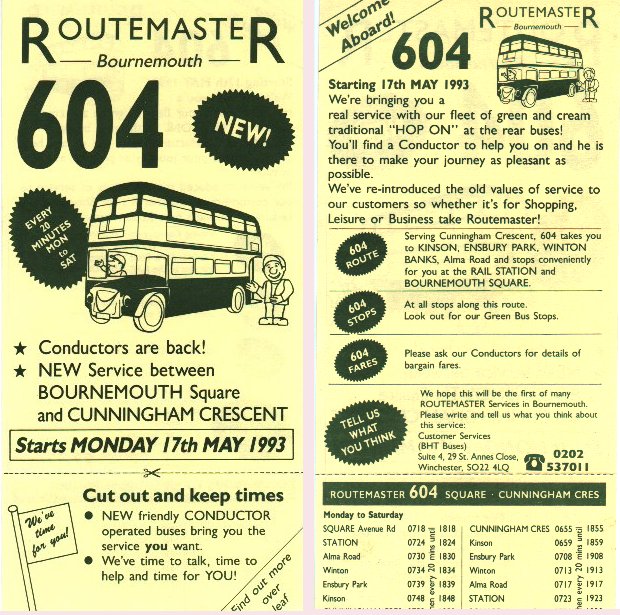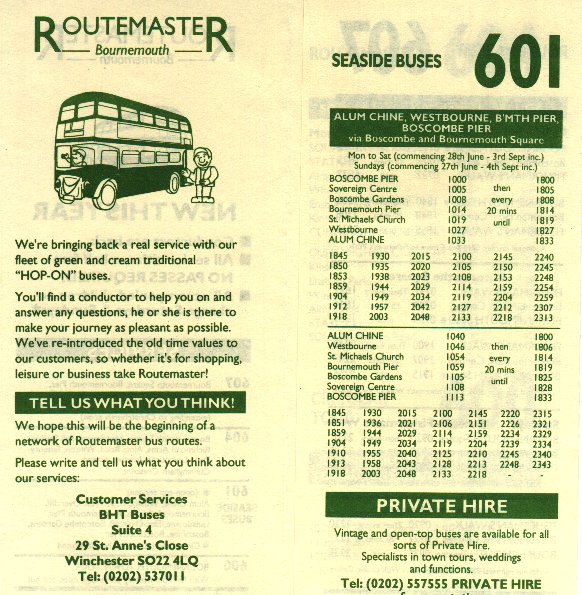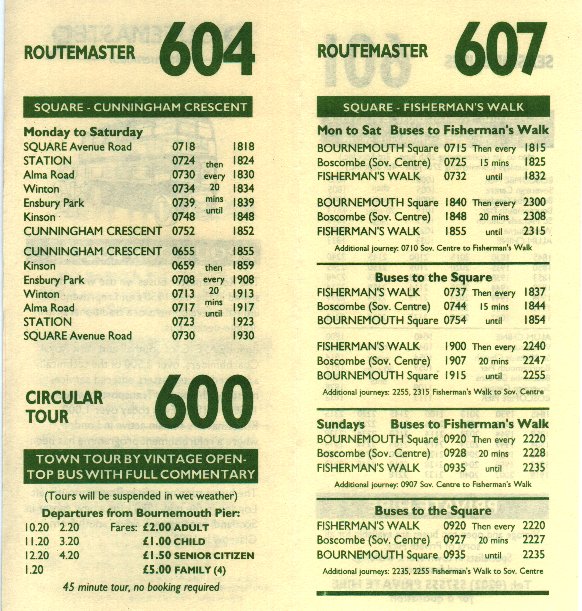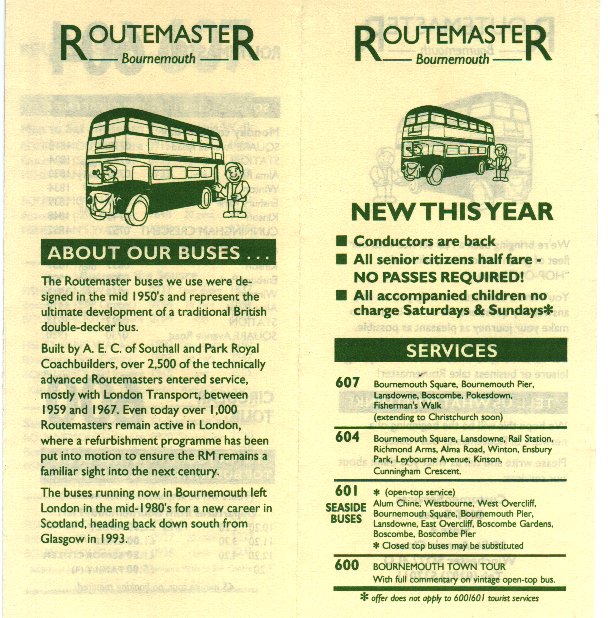
ROUTEMASTER BOURNEMOUTH
When buses competed in the streets of Bournemouth
And bus conductors staged a come back ...... in 1993 and 1994
Please note - this is a site of historical record and does not contain current service information
|
It all started on Monday
17th May 1993 with four crew operated
Routemasters running on route 604 from The Square in central
Bournemouth and out
through Charminster, Winton, Ensbury Park and Kinson to a terminus
at Cunningham Crescent (West Howe).
Routemaster Bournemouth operated from rented garage space in the former trolleybus depot in Southcote Road, and the traffic office was in what had once been the trolleybus conductor's cashing up and paying in room. Part of the reason for the start of the Routemaster operation - apart from perceived commercial opportunity - was a need to generate income for a transport museum in Bournemouth. Several of the directors were involved with both the bus operation and the museum. The 604 service was
quickly followed on 11th June by three more
Routemasters working
route 607 from Bournemouth Square to Boscombe and
Fishermans Walk, and then on 26th June by the open top seaside route
601, linking Boscombe Pier
and Bournemouth Pier to Alum Chine via the overcliff drives.
The weekday run out at this time totalled twelve buses (including one for the circular tour service 600), but only seven were needed on Sundays when the 604 did not operate. On weekdays bus workings 1 to 4 covered the 604, 11 to 13 were on the 607, and 21 to 24 on the seafront 601. On weekdays there were 15 crew duties and on Sundays 8 crew duties, in both cases supplemented by two OPO duties for the evening service on the 601. An additional crew of driver and guide operated the 600 circular tour. A weekly 'Mastercard' costing £5 (£3 pensioners or children) was introduced for unlimited travel on the green bus Routemaster services. |
|
|
| The first timetable for the 604 in May 1993 |
||
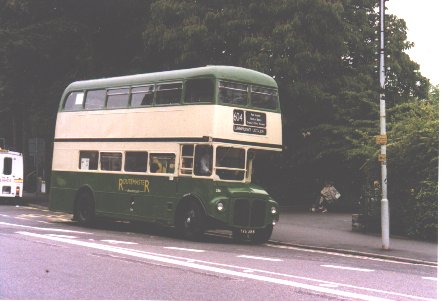 |
In the first week of
operations, YVS286 (once it had been London Transport's RM809) is seen approaching the Gervis Place
stop at Bournemouth Square on an incoming 604 service. Eleven Routemasters were acquired in March 1993, ten of which came from Kelvin Central Buses in Scotland, the other from Taylor of Morley. With the exception of ALM83B from Kelvin - which retained its registration - the others were reregistered YVS285 to YVS294, with equivalent fleet numbers allocated. Another twelfth Routemaster ALD959B was loaned by Humphreys of Watford (a preservationist) whilst a thirteenth WLT621 was hired from Roger Brown of Shaftesbury. All were repainted in the green and cream livery of Routemaster Bournemouth. These two vehicles had been respectively RM1959 and RM621 with London Transport. |
|
| The 1993 timetables incorporating new
route 607 to Boscombe and Fishermans Walk |
||
|
|
|
|
|
|
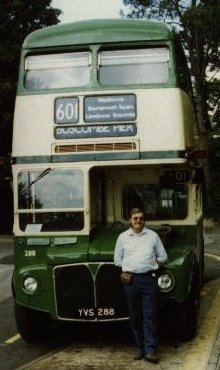 |
|
| RM 288 at Alum Chine in 1993 awaiting departure on the summer seafront 601 route to Boscombe Pier (with yours truly driving). |
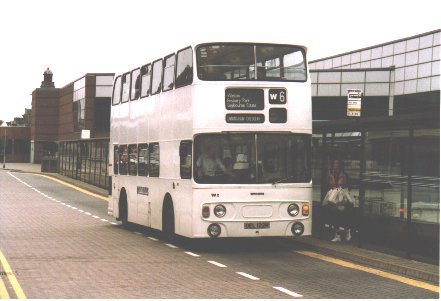 |
Incumbent Bournemouth
town service
operator
Yellow Buses soon
responded to the perceived attack on their routes by this "upstart"
Routemaster
operation!
A fleet of "White Buses" appeared - but only on the services covered by Routemaster - with the timetable registered to run a few minutes in front of each Routemaster departure. The picture alongside shows White Bus OEL122M at Bournemouth rail station - route W6 shadowed (or rather preceded) the 604s to Kinson and West Howe. Similarly the W2 covered the 607 route to and from Fishermans Walk. In the summer of 1993 the
Routemaster Bournemouth fleet was all double-decked, and comprised
thirteen RMs, three Atlanteans and three Fleetlines. Shortly after
this though Leyland Nationals would arrive and an emphasis would be
placed on one person vehicles. |
|
A
further timetable revision from 2nd December 1993 saw the 605 withdrawn
over the outermost section of route between Kinson and Bear Wood and
diverted instead to run to West Howe, thus becoming a circular service
through Kinson and
West Howe with the 604. The 604 in turn had been rerouted to
operate from Leybourne Avenue along East Howe Lane to West Howe and
thus to Kinson. Vehicles through-routed at Kinson to provide the
circular service in both directions.
Also at this time the 607 and 608 services were cut back at their outer end from Somerford by about a mile to Purewell Cross. From 14th December new White Bus route W1 was introduced to cover the 608 service which had previously been ignored by the competition. On 1st January 1994 the operating base was moved from Southcote Road to the same hangar as was in use by the transport museum collection at Hurn Airport, a few miles north of Bournemouth. In this large hangar Vickers Viscount and BAC111 aircraft had once been constructed in years gone by. Spring 1994 saw another timetable issued and the 607 and 608 were once again extended back out to their Somerford terminus from 14th March. The 608 was diverted away from Tuckton Road, Southbourne, along Belle Vue Road. The company celebrated its first anniversary on 17th May 1994 and RM 293 operated in service on the 607 route with a suitable commemorative shield on high over the top deck front windows. The seafront 601 service was reintroduced from 28th June as was circular tour 600. White buses W1 and W2 were withdrawn from 13th June but increased frequencies were operated on the pre-existing similar 'traditional' Yellow Bus 20 and 23 services. |
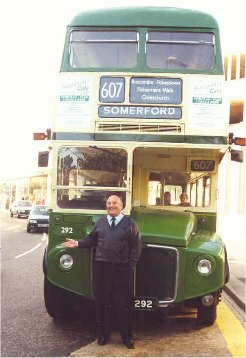 |
|
| RM 292 awaits another departure on the 607 service to Somerford with driver Peter Holmes |
A planned new route that summer was to have been the 606 to operate from Bournemouth Square through Boscombe and Iford to Christchurch, following the line of the Yellow Bus 20 route, but initially to be operated evenings and Sundays only. However the 606 never came to fruition apart from a short-lived single weekday departure from Bournemouth at 18.18, which through a quirk of the duty scheduling was a depot working from a crew operated running line on the 607.
The competitive commercial operation by Routemaster Bournemouth had been in part supported by Clydeside 2000 from Scotland, with both supply of vehicles and financial input. The ownership of Clydeside 2000 passed to Luton & District and the support given hitherto to Routemaster Bournemouth ended, which was a significant factor in the financial problems which led to voluntary liquidation. There had been too a certain irony in the operations having been based in the former trolleybus depot which had latterly been the home of the council's dustbin lorries and street cleaning vehicles. So the same council was renting space to accommodate buses that were competing on the road with the buses of their own transport department!
But by this second summer season things had
started
to go wrong, and runs were being missed, especially on the 604s and
605s. Competitive operations ceased with the unfortunate collapse
of Routemaster Bournemouth after fifteen
months operation.
Efforts were made to attract additional investment but green bus
operations ceased suddenly for
financial reasons after 10th August 1994, by which time only three
Routemasters
were scheduled for daily service (on route 607 short workings from
Bournemouth to
Tuckton Bridge)
out of a by then weekday operational requirement of nearly twenty
vehicles.
Although there had been a flurry of competitive workings by several companies in the Bournemouth area in 1986 and 1987 following the introduction of bus deregulation, by the time of the advent of the Routemaster operation the incumbent companies had had six or seven years to consolidate their position in the conurbation. Also Routemaster (unlike some of the earlier competitors like Charlies's Cars with their minibuses linking new areas) contributed little new except the 'novelty' of crew operation, and that advantage was soon eroded by a change to substantial amounts of one person operation.
|
Join me on late turn 114 duty - they used to pay me to drive a Routemaster ! |
From Routemaster to Shamrock Buses The story continued |
| DORSET
(RURAL) |
DORSET (URBAN) |
SOMERSET |
WILTSHIRE |
HAMPSHIRE |
| FAROE ISLANDS |
NORMANDIE |
ISLE OF SKYE |
LINKS |
LINCOLNSHIRE |
